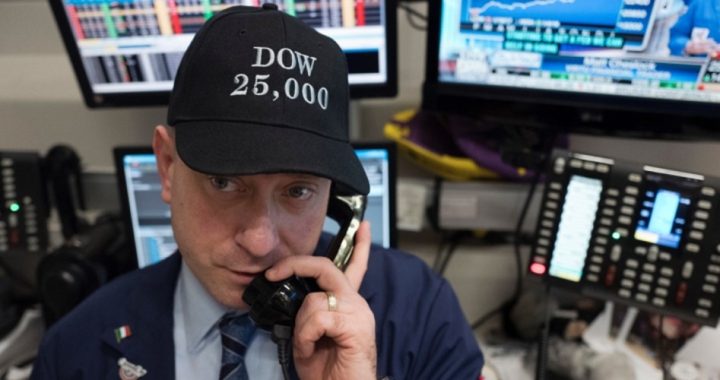
The surprising thing about the Dow’s volcanic eruption through the 25,000 level on Thursday is that it was matched by all-time highs in other key stock market indexes such as the S&P 500 Index, the NASDAQ, and the Russell 2000. Even more surprising is that this isn’t happening in an American vacuum: Japan’s Nikkei Stock Average hit a new 26-year high, rising above 23,000 for the first time since January 1992. The Hang Seng (Hong Kong) Index just touched a new 10-year high, while major stock market indexes in New Zealand, the Philippines, and Thailand also set new records on Thursday.
The reasons why aren’t surprising: the American economy, significantly unfettered from excessive regulations for the first time in eight years, is not only reviving but getting stronger with each new economic report. October, November, and December’s sales figures were far ahead of forecasters’ predictions with year-end results coming in way ahead of expectations. New car sales, new construction, energy development, not to mention year-end bonuses and announcements of salary increases and new capital investment following passage of tax reform are all driving the American economy higher.
Nearly a million more Americans are working now than a year ago, dropping unemployment to 4 percent, with the Fed predicting numbers approaching 3.5 percent as the economy continues to steamroll ahead. The country’s gross domestic product (GDP) is running at more than three percent, astonishing even the most optimistic forecasters. Coupled with highs in investor, business owner, and consumer sentiment, the stage is set for further improvements into 2018.
All the stock market is doing is predicting the future.
The record run is truly astonishing. It took just 23 trading days for the Dow to gain 1,000 points (from 24,000 on November 30 to over 25,000 on Thursday). The Dow broke through five – five! – thousand-point levels in 2017 as it gained close to 5,000 points for the year.
A little history is instructive to show the remarkable performance of the American stock market over the past 18 years. In early May 1999 the Dow broke through the 10,000 level for the first time in history, dropping 2,100 points to 7,900 by March 2003 but bouncing back to 13,750 by October 2007. Following the real estate crisis that triggered the Great Recession the market dropped to a low of 6,500 in March 2009 and it’s been nearly straight up ever since.
Scott Wren, senior global equity strategist for Wells Fargo Investment Institute, thinks the market has much more room to run: “Dow 25,000 is something that your average investor [is] going to be wondering why they’re still sitting in cash and why they’re not invested the market as they should be?” Wren says the market’s performance doesn’t reflect a buyers’ “frenzy” which gives him comfort that higher highs will continue to be notched in the New Year.
There’s a political angle to the market’s remarkable run as well, according to Peter Ferrara. Ferrara served President Ronald Reagan in his Office of Policy Development and is now senior fellow at the conservative Heartland Institute. Ferrara holds that the mid-term elections, which in the past have hammered the party occupying the White House, will instead punish the Democrats:
The first reason is that tax reform is going to work spectacularly with Trump’s deregulation to finally restore booming economic growth of four percent a year or more. Just like President John F. Kennedy’s tax cuts in the 1960s and President Ronald Reagan’s tax cuts in the 1980s, the critical tax rate cuts in the 2017 tax reform legislation will result in skyrocketing investment, flooding job creation, surging wages, swelling labor supply, rocking business expansion, rolling business creation and booming growth.
This will cost Democrats dearly in the November midterms, for a very simple reason, says Ferrara: “This economic boom will boost Republican candidates by November, all the more because not one Democrat voted for the tax reform.”
Further, the average voter will shortly discover that Democrats and the mainstream media have been lying to him about the impact of Trump’s tax reform:
That will result in part because tax reform cuts taxes on the middle class and working people directly, which the Democrat-controlled media has strived mightily to keep secret….
This is why tax reform focused on cutting corporate and business taxes, bravely doing the right thing for working people and the middle class. Too many voters do not understand this because the Democrat-controlled media won’t tell them.
Reality, according to Ferrara, will shortly kick in:
Democrats will surely be hurt when voters realize that they and their media lied to them about tax reform. Blue collar workers and the middle class will see their taxes decline, and the fabrications about over 80 percent of the tax benefits going to the top 1 percent will be disrobed.
If it’s true that voters will vote their pocketbooks in November, then the MAGA economy will likely turn out of office Democrats who have steadfastly opposed the Trump agenda and reflect instead comments from those hapless Democrats such as Rep. Nancy Pelosi of California and Sen. Charles Schumer of New York who have decried tax reform. Said Pelosi, “If this [tax reform] goes through, kiss life on earth goodbye … this is Armageddon.” Senate Minority Leader Chuck Schumer added, “Tax breaks don’t lead to job creation … [tax reform is a] punch in the gut for the middle class.”
The most bullish thing the stock market can do is to continue to move higher. It may also be a “tell” for the midterm elections in November as well.
Photo: AP Images
An Ivy League graduate and former investment advisor, Bob is a regular contributor to The New American magazine and blogs frequently at LightFromTheRight.com, primarily on economics and politics. He can be reached at [email protected].
Related article:
U.S. Economy’s Stunning Performance Continues to Bewilder Forecasters



